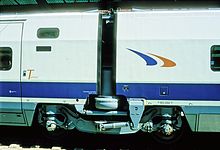Articulated train (rail)

Middle: Articulated train with Jakobs bogies
Below: Articulated train system Talgo

An articulated train is a train whose wagons are supported on shared drives . They cannot be separated from each other in normal railway operations and are now used in passenger transport both in high-speed traffic and in local traffic . Compared to trains from conventional passenger coaches, articulated trains have a lower empty weight , since fewer drives are required for the same train length and parts of the braking equipment only have to be arranged once for the entire train. Most of the articulated trains are designed with Jakobs bogies , which also connect the car bodies to one another. In the case of trains that use short car bodies, these can be made wider than conventional passenger carriages, so that the clearance profile is better used. Disadvantages are the higher axle loads compared to conventional trains and the inability to adapt the train to the traffic volume. In rail freight transport , the principle is used with two-part flat wagons and multi-part double-deck container wagons .
history
The first articulated trains were built in the 1930s. Early examples in Germany were the double-decker streamlined push-pull trains of the Lübeck-Büchener Railway or the Flying Hamburger , in America the Goodyear- built Comet for the New York, New Haven and Hartford Railroad .
Articulated trains of the Talgo type were developed in Spain in the 1940s . In this system, the intermediate carriages have a loose wheel set at one end , while the other end is supported on its neighboring car.
After the Second World War , the double-decker units from Waggonbau Görlitz followed . They were delivered to the Deutsche Reichsbahn as well as the Czechoslovak and Polish state railways. In their basic concept, they followed that of the LBE's double-decker push-pull trains. In order to maintain the axle running mass even on routes with a light superstructure, these units were given three-axle Jakobs bogies. Originally four-part, later some two-part units were made. Subsequent deliveries were only made in four parts, from 1971 also with a control compartment for using the units as push-pull trains. Older sets were also retrofitted with driver's cabs. However, units capable of turning trains were only used by the DR. Deliveries from 1971 onwards can be recognized by the lightweight construction of the car bodies with internal reinforcements that also support the seats and thus by the seat divider 2 + 2. The railway designated the units as DB13, from 1970 DBv and DB7, from 1970 DBz, most recently DBx, as double-decker trains . In 1959 the first five-part DGB12 appeared, from 1970 DGBe for the middle and DGBse for the end cars, with regular bogies under the DGZ intermediate cars. They were intended for long-distance traffic and were referred to by the manufacturer and then also by the operator as double-decker articulated trains . In these units, the end cars at the service coupling end ran on two-axle bogies, short, separate intermediate cars were inserted between the car bodies, which only contained the entry area and ran on a bogie. The middle and end cars supported themselves on the intermediate cars, which were guided horizontally and vertically using handlebars in the sloping roof. With this construction, the double-decker articulated trains were characterized by a double-decker proportion of 80% of the standard length, which was never reached again, and by a roll-free and lurch-free run. To connect with the double-deck generator and buffet cars, the end cars of the 1959 type were given high transitions. A disadvantage of the large amount of space was the axle load of the intermediate car. Despite its radical lightweight construction, it exceeded the permissible values on the main railways with 200% occupancy.
Another type of double-decker articulated train was delivered in 1970. They should only be used in regional traffic. Because of this, and because lightweight three-phase claw-pole generators flanged to the axle bearings, the special generator and buffet cars were no longer necessary. This made the high car crossings superfluous. The possible axle load excess was countered by shortening the middle and end cars by one compartment each. The majority of the units received a driver's cab on one end car for push-pull operation. A UIC intercar transition was installed at the ends free of the driver's cab.
In the 1950s, two articulated trains of the VT 10.5 series were procured for the Deutsche Bundesbahn , which were unsuccessful. The trains with six diesel engines per train were too maintenance-intensive and prone to failure.
In France, the TGVs used in high-speed traffic were designed as articulated trains. Their car bodies are shorter and wider compared to normal passenger coaches.
Examples
Articulated trains with Jakobs bogies :
- Zephyr trains on the Chicago, Burlington and Quincy Railroad
- LBE double-decker streamlined push-pull train
- TGV
- 425 series
- DB class VT 10.5
- Bombardier talent
Articulated trains of other types:
See also
Individual evidence
- ↑ Jürgen Janicki, Horst Reinhard: Rail Vehicle Technology . Bahn Fachverlag, 2008, ISBN 978-3-9808002-5-9 , p. 522–.
